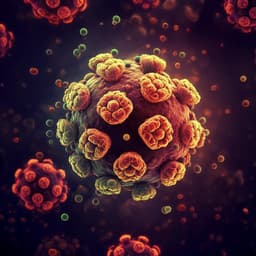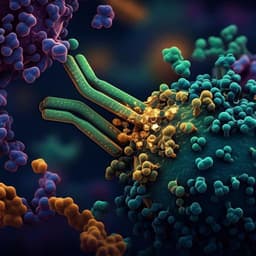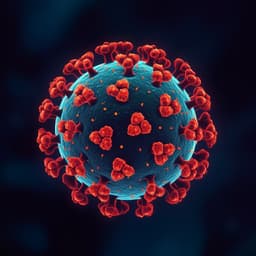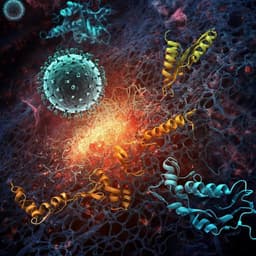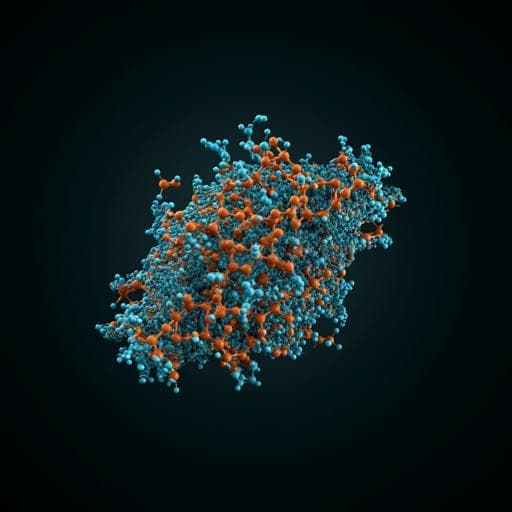
Medicine and Health
A variant-proof SARS-CoV-2 vaccine targeting HR1 domain in S2 subunit of spike protein
W. Pang, Y. Lu, et al.
The emerging SARS-CoV-2 variants threaten vaccine efficacy, prompting the need for a variant-proof solution. Researchers, including Wei Pang and Ying Lu, have developed HR121, a recombinant subunit vaccine targeting a conserved region of the S2 subunit of the spike protein. HR121 has shown promise in eliciting potent cross-neutralizing antibodies and providing protection against various SARS-CoV-2 strains, showcasing its potential as a game changer in the fight against COVID-19.
~3 min • Beginner • English
Introduction
SARS-CoV-2 variants of concern, especially Omicron sublineages with strong immune evasion and transmissibility, challenge COVID-19 control and motivate development of variant-proof or pan-sarbecovirus vaccines. The spike protein mediates entry: S1 binds ACE2, while S2 drives membrane fusion. Current vaccines focus on S1, particularly RBD/NTD, which are immunodominant but mutate under immune pressure, reducing effectiveness and enabling breakthrough infections. By contrast, S2 is more conserved and buried in prefusion spike, typically inducing few neutralizing antibodies after infection or vaccination with full S2. The S2 heptad repeat domains HR1 and HR2 are highly conserved and form the fusion machinery: upon fusion activation, HR1 and HR2 become exposed in a prehairpin intermediate before collapsing into a six-helix bundle (6-HB). HR2-derived peptides and rare HR2-directed monoclonal antibodies can block this conformational transition, showing broad antiviral activity, suggesting HR1/HR2 in the fusion intermediate as vaccine targets. However, the fusion intermediate is transient and structurally unresolved, making design of mimetic immunogens difficult; prior HR1/HR2 mimetics in HIV-1 and influenza elicited weak neutralization. This study proposes and tests a new strategy: a recombinant HR121 protein that mimics the HR1 trimeric inner core of the S2 fusion intermediate to elicit broad and potent neutralizing antibodies and protection against SARS-CoV-2 and variants including Omicron.
Literature Review
Prior work established that S1-targeted vaccines (RBD/NTD) elicit strong neutralizing responses but are susceptible to antigenic drift, diminishing efficacy against variants such as Alpha, Beta, Gamma, Delta, and Omicron. The S2 subunit, with conserved HR1/HR2, underlies membrane fusion; HR2-based peptides and some HR2-directed antibodies can broadly inhibit coronaviruses and even other class I viruses by targeting the prehairpin intermediate. Attempts to design vaccines against the transient fusion intermediate in HIV-1 (e.g., 5-Helix, various HR1 trimers) and influenza yielded limited neutralization, likely due to instability/transience and suboptimal epitope presentation. Recent RBD-HR conjugate vaccines used HR1/HR2 as scaffolds/adjuvants to enhance responses, but a coronavirus vaccine directly targeting HR1 of the fusion intermediate had not been demonstrated. These studies motivate targeting conserved S2 epitopes and inform design constraints for mimicking the fusion intermediate to induce broad neutralization.
Methodology
Design and protein engineering: HR121 was designed from SARS-CoV-2 Wuhan-Hu-1 S2 heptad repeats as HR1-linker1(HR1: aa 912–988)-HR2-linker2(HR2: aa 1163–1206)-HR1 with flexible linkers (GGSGG, SGGRGG). The gene was cloned with an N-terminal SUMO tag for bacterial expression; HR1, HR2, and a 6-HB scaffold HR12 were also expressed separately. Expression and purification: Proteins were expressed in E. coli BL21 (DE3), purified by Ni-affinity chromatography, SUMO tag removal (for HR121), and size-exclusion chromatography (Superdex 200). HR121 yield was 10–20 mg/L at >95% purity; it appeared as a dimer by native PAGE. Structural characterization: X-ray crystallography resolved HR121 at 2.41 Å (PDB 7WXZ). The structure showed an asymmetric 6-HB-like complex: four HR1 helices (α1–α4) forming two HR1 trimers with two antiparallel HR2 helices; two surface grooves in the outer HR1 trimer remained unoccupied, providing putative antigenic sites for HR2 binding. Biophysical/biochemical assays: GST pull-down demonstrated selective binding of HR121 to HR2, not HR1. Surface plasmon resonance measured HR2–HR121 affinity (KD ~0.686 nM; ka 5.48×10^5 M−1s−1; kd 3.76×10^−4 s−1). Circular dichroism showed HR121 is α-helical and forms a more stable helix upon mixing with HR2, consistent with 6-HB-like interactions; no interaction with HR1 was observed. Immunizations: • Rabbits: Subcutaneous prime-boost-boost (Day 0: 100 µg; Days 21 and 42: 150 µg) with HR121 in CFA/IFA; HR12 comparator group; adjuvant controls. • BALB/c mice: Subcutaneous HR121 (2, 10, 50 µg) with CFA/IFA at 2-week intervals (3 doses) with longitudinal sampling; separate cohort at 3-week intervals. • hACE2 transgenic mice: Subcutaneous HR121 10 µg with CFA/IFA at 2-week intervals (3 doses), then high-dose SARS-CoV-2 intranasal challenge (10^7 TCID50). • Syrian golden hamsters: Subcutaneous HR121 15 µg with CFA/IFA (3 doses) for short-term (2 weeks post-boost) and long-term (3 months post-boost) protection studies with prototype SARS-CoV-2 challenge (10^4 TCID50). Omicron BA.2 efficacy: HR121 in CFA/IFA or aluminum adjuvant (Alhydrogel), intramuscular in aluminum arm; challenge with BA.2 (10^3 TCID50). • Rhesus macaques: Subcutaneous HR121 50 µg with IFA at monthly intervals (3 doses), then SARS-CoV-2 challenge (3×10^7 TCID50 intranasal/intratracheal). Passive transfer: Purified rabbit anti-HR121 IgG (5 mg/20 g body weight) administered to naive hACE2 mice and hamsters, followed by challenge. Immunological assays: • ELISA for binding antibody endpoints to HR1, HR2, HR12, HR121. • Competitive ELISA for inhibition of HR2–HR121 binding (sera NT50, IgG IC50). • ELISpot for HR1-specific IFNγ T-cell responses and HR121-specific antibody-secreting cells in mice. Neutralization assays: • VSV-based pseudovirus neutralization against Wuhan-Hu-1, point mutants (S477N, E484K, N439K, A222V, K417N, D839Y, D614G) and variants (Alpha, Beta, Gamma, Delta, Lambda, Mu, Omicron BA.1/BA.2/BA.3/BA.4/5). • Authentic virus neutralization in HPAEpiC cells (MOI=1). Virology and pathology: • qRT-PCR for gRNA (N gene) and sgRNA (E gene) in swabs and lung tissues to assess viral load and replication. • Histopathology (H&E) and immunohistochemistry for SARS-CoV-2 N protein. • Cytokine mRNA profiling in mouse lungs (IFNG, IL2, IL4, IL6, IL10, IP10, MX2, TNFA). Ethics and biosafety approvals were obtained; SARS-CoV-2 work conducted in BSL-3.
Key Findings
• Structural and functional mimicry: HR121 forms a stable dimeric assembly mimicking an HR1 trimeric inner core with two unoccupied grooves, binds HR2 with subnanomolar affinity (KD 0.686 nM), and does not bind HR1, consistent with a fusion-intermediate analog. • Rabbits: – High binding titers to HR121 (geometric mean endpoint ~1.3×10^7), 6-HB (5.4×10^6), HR1 (2.4×10^6), and low to HR2 (3.0×10^5). – Neutralization: pseudovirus NT50 geometric mean ~1.7×10^4; authentic virus NT50 ~1.0×10^4. Purified IgG IC50: 346 ng/mL (pseudovirus) and 1312 ng/mL (authentic). – HR12 comparator elicited higher binding to HR12 but much weaker neutralization (GMT ~4.8×10^2; 34.4-fold lower than HR121). – Competitive ELISA: anti-HR121 sera/IgG potently inhibited HR2–HR121 binding (sera NT50 ~2.3×10^3; IgG IC50 ~663 ng/mL); human convalescent/vaccinee sera did not inhibit, indicating unique fusion-targeting antibodies. – Breadth: Rabbit sera neutralized point mutants (NT50 ~6.0×10^3–3.6×10^4), historical variants (NT50 ~1.8×10^3–4.3×10^4), and Omicron BA.1 (6.6×10^3), BA.2 (2.6×10^3), BA.3 (2.0×10^3), BA.4/5 (5.0×10^3). – Passive transfer: Anti-HR121 IgG conferred sterilizing protection in hACE2 mice (6/6 no gRNA) and hamsters (7/9 no gRNA; remaining with no sgRNA), indicating in vivo neutralization. • BALB/c mice: – Robust and durable binding responses after 3 doses (GMT ~1.0×10^6–1.6×10^6), with modest decline over 2 months; 3-week intervals yielded lower titers than 2-week intervals. – Authentic virus neutralization reached NT50 ~4.0×10^4 after third dose. – Sustained cellular immunity: HR1-specific IFNγ ELISpot responses and HR121-specific antibody-secreting cells persisted 90 days post-boost. • hACE2 transgenic mice: – Binding GMT ~1.3×10^6; authentic virus NT50 ~3.3×10^3. – Challenge (10^7 TCID50): 7/8 fully protected; 1 with residual gRNA but no sgRNA; reduced inflammatory and antiviral cytokine expression; minimal lung pathology and no N protein detected. • Syrian golden hamsters (prototype challenge): – Binding GMT ~8.1×10^3; authentic NT50 ~3.5×10^2; dose-dependent in vitro inhibition. – Short-term (2 weeks): 3/10 with low gRNA; no sgRNA; normal lung histology. – Long-term (3 months): ~5-log median gRNA reduction (6/8 with low gRNA); no sgRNA; minimal pathology, demonstrating durable protection. • Rhesus macaques: – Binding IgG GMTs increased to 6.9×10^5 after third dose; authentic virus NT50 ~1.1×10^3. – Cross-neutralization (pseudovirus): modest 1.5–2.9-fold drops for Alpha, Beta, Gamma, Delta, Lambda, Mu vs Wuhan; Omicron BA.1 3.9×10^2, BA.2 2.5×10^2, BA.3 2.3×10^2, BA.4/5 4.0×10^2. – Challenge (3×10^7 TCID50): Controls had high, sustained gRNA in nasal/throat swabs; HR121 group had transient low gRNA early and no sgRNA in swabs at any time. In lungs, controls had high gRNA; HR121 group had gRNA in only one animal without sgRNA. Pathology markedly reduced; minimal weight/temperature changes vs controls. • Omicron BA.2 hamster challenge and adjuvant comparison: – HR121 with aluminum adjuvant elicited binding (GMT ~1.5×10^5) and neutralization (NT50 ~1.8×10^2) comparable to CFA/IFA (binding GMT ~3.2×10^5; NT50 ~2.8×10^2). – Post-challenge (3 dpi): In vaccinated groups, gRNA detected in 5/12 (CFA/IFA) and 4/12 (aluminum) with ~5.3 and ~5.0 log median reductions; sgRNA in 3/12 and 1/12 with ~4.4 and ~4.0 log reductions; minimal pathology compared to adjuvant-only controls. Overall, HR121 elicited broad, cross-variant, fusion-targeting neutralization and conferred near-complete protection in multiple animal models, including effective protection against Omicron BA.2.
Discussion
Targeting the conserved HR1 region of the S2 fusion machinery addresses the challenge posed by S1 mutations that erode vaccine and antibody efficacy. HR121 structurally mimics the HR1 trimeric core of the fusion intermediate, exposing grooves that are targeted by elicited antibodies which block HR2 engagement and thereby inhibit six-helix bundle formation and membrane fusion. This mechanism explains the broad cross-neutralization across variants, including Omicron sublineages whose mutations concentrate in S1. The strong correlation between inhibition of HR2–HR121 binding and viral neutralization supports the intended mode of action. Protective efficacy across species—mice, hamsters, and macaques—with minimal pathology and no detectable replication (absence of sgRNA) demonstrates that HR121-induced antibodies are sufficient for protection without evidence of antibody-dependent enhancement. Compared to prior fusion-intermediate mimetics in HIV-1 and influenza that yielded weak neutralization, HR121 likely benefits from full-length HR1/HR2 sequences, favorable epitope presentation via unoccupied HR1 grooves, and spatial accessibility in the coronavirus fusion intermediate. The strategy complements existing S1-focused vaccines, offering a variant-resilient approach and potential for integration into diverse platforms (protein subunit with aluminum adjuvant, viral vectors, VLPs, DNA/mRNA). The conserved nature of HR domains suggests extensibility to pan-sarbecovirus vaccines and possibly other class I viruses, guided by accessibility of prehairpin epitopes.
Conclusion
This work introduces HR121, a recombinant immunogen that mimics the HR1 trimeric core of the SARS-CoV-2 S2 fusion intermediate, eliciting potent and broad neutralizing antibodies that target membrane fusion. HR121 induced cross-variant neutralization, including Omicron sublineages, and provided near-complete protection in hACE2 mice, Syrian golden hamsters (short- and long-term), and rhesus macaques, with effective protection against Omicron BA.2 using either Freund’s or aluminum adjuvant. The study establishes S2 HR1 as a viable conserved target for variant-proof COVID-19 vaccines and outlines a design principle for fusion-intermediate mimetics. Future work should define structural epitopes of HR121-bound antibodies, expand sample sizes for immune correlates, optimize formulations for clinical translation, assess T-cell contributions, and explore adaptation of this strategy to other coronaviruses and class I enveloped viruses.
Limitations
• Structural complexes of HR121 with HR2 and with elicited antibodies were not solved; conformational changes upon binding and precise neutralizing epitopes remain undefined. • Small animal cohorts (especially in rabbits and macaques) and relatively homogeneous responses limited detailed correlation analyses between competitive binding inhibition and neutralization. • Post-challenge anamnestic neutralizing antibody responses were not measured, given undetectable sgRNAs and expected minimal boosting in near-fully protected models. • Cellular correlates of protection, particularly CD4+ and CD8+ T-cell responses, were not comprehensively characterized.
Related Publications
Explore these studies to deepen your understanding of the subject.



